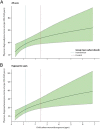Household air pollution is a major avoidable risk factor for cardiorespiratory disease
- PMID: 23131939
- PMCID: PMC5991547
- DOI: 10.1378/chest.12-1596
Household air pollution is a major avoidable risk factor for cardiorespiratory disease
Abstract
Household air pollution (HAP) from biomass fuels, coal, and kerosene burned in open fires, primitive stoves, and lamps causes at least 2 million deaths per year. Many of these deaths occur in children <5 years of age with pneumonia and in women with COPD, lung cancer, and cardiovascular disease. HAP is inextricably linked to poverty, with activities to obtain fuel consuming a large proportion of the time and financial resources of poor households. Thus, fewer resources used in this way means less is available for basic needs like food, education, and health care. The burden of work and the exposure to smoke, particularly during cooking, are predominantly borne by women and children. Although historically HAP has not received sufficient attention from the scientific, medical, public health, development, and policy-making communities, the tide has clearly changed with the broad-based support and launch of the Global Alliance for Clean Cookstoves in 2010. There is now considerable reason for optimism that this substantial cause of cardiorespiratory morbidity and mortality will be addressed comprehensively and definitively. Drawing on our experience from four continents, we provide background information on the problem of HAP, health impacts of HAP, opportunities for research, and the current best solutions.
Figures




References
-
- Quantifying Environmental Health Impacts WHO . Global Estimates of Burden of Disease Caused by Environmental Risks. World Health Organization; Geneva, Switzerland: 2009.
-
- World Health Organization . Global Health Risks. Mortality and Burden of Disease Attributable to Selected Major Risks. World Health Organization; Geneva, Switzerland: 2009.
-
- Venkataraman C, Rao GU. Emission factors of carbon monoxide and size-resolved aerosols from biofuel combustion. Environ Sci Technol. 2001;35(10):2100–2107. - PubMed

